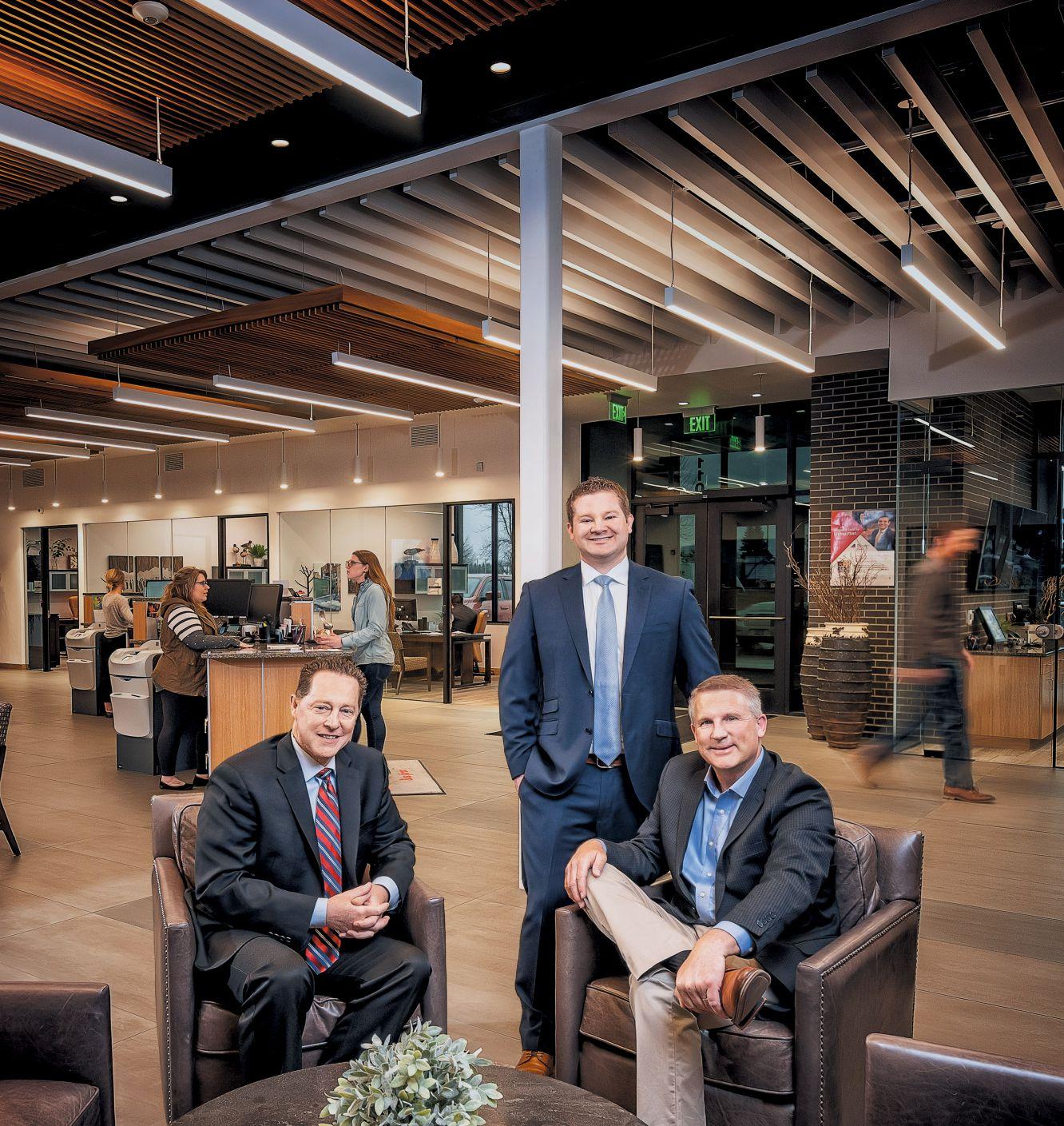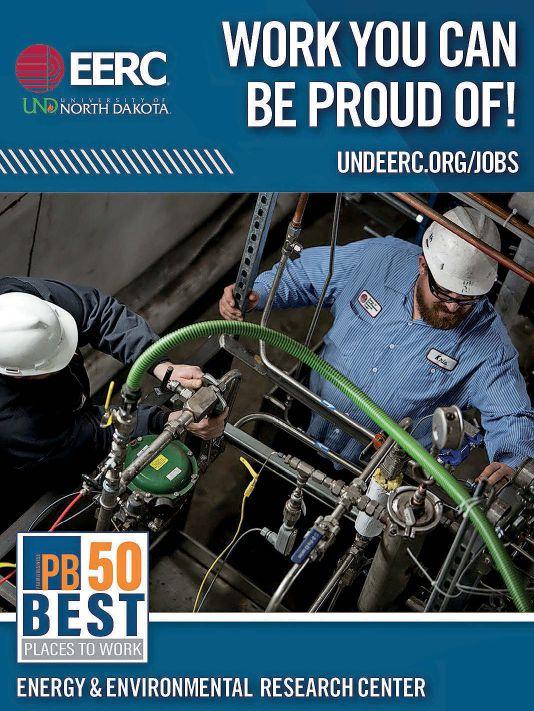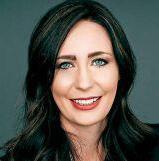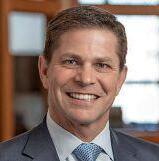ON REGIONAL HOUSING MARKET

INTEREST RATES, LINGERING PANDEMIC EFFECTS IMPACT BUSINESS
JUMPING ON THE STUDENT DEBT TREADMILL


INTEREST RATES, LINGERING PANDEMIC EFFECTS IMPACT BUSINESS
JUMPING ON THE STUDENT DEBT TREADMILL


To al lt he mo ve rs ,s ha ke rs ,a nd di ff er encema ke rs —J LG Ar ch it ec ts ta ke sy our st or yb eyon dt he bu il di ng to emp ower th ep eop le wh or ef le ct yo ur pass io na te jo ur ne y. We ’r et al ki ng ab ou td yn am icdesi gn th at spea ks vo lu me sa bout yo ur missi on ,y ou rc ultu re ,a nd yo ur co mm un it y. Se eh ow Fi rs tI nt er na ti on al Ba nk & Tr ust em brac es transf or ma ti ve desi gn fo rthe grea te rg oo da tJ LG arch itec ts .c om.


Goodnews: Nor thDakotaismatching employer-ledchildcarebenefits.


Thisprogramcouldmake adifferenceinhelpingyouattract andretainhardworkingparents. To optintoofferthese benefitsorenhancethechildcarebenefitsyoumayalready offer,visit hhs.nd.gov/childcare.

MAY EDITION | APRIL 13

JUNE EDITION | MAY 11
JULY EDITION | JUNE 12


CULT UREISTHEDIFFERENCE BE TWEEN AJOB ANDA CAREER.
At NI SC,culture isn’t just abuz zwordtossedaroundaboardroom.Innovation, creativity and collaborationare the bedrock of NI SC…A nd youcan seeitinpracticeevery single day. We take care of ouremployees, and they take care of ourMembers.It’sasimpleconcept,anditisthe reasonourtechnology is implementedinall 50 states,reliablyser ving millionsofenergyand broadband customers.

Formoreinformationvisit NISCValue.coop




IN THE PROFESSION. ERIC HYLDEN / FOR PRAIRIE BUSINESS


REALTOR AMBER CARLTON SHOWS OF THE LIVING ROOM WHILE GIVING A HOME TOUR TO CANDACE STOCK ON MONDAY, MARCH 13, 2023. THE THOMSEN HOME IS LOCATED IN FARGO.

ALYSSA GOELZER / THE FORUM OF FARGO-MOORHEAD

ENCLAVE HAS HIRED TWO NEW MEMBERS TO ITS TEAM ANDY BRENDEN WILL BE A SENIOR ACCOUNTANT. BRENDEN WILL SUPPORT THE COMPANY BY LEADING FINANCIAL WORKFLOWS, PREPARING DATA, CONDUCTING RESEARCH, AND FORECASTING FINANCIAL INITIATIVES. BRENDEN RECEIVED HIS BACHELOR’S DEGREE IN ACCOUNTING FROM MINNESOTA SCHOOL OF BUSINESS. PRIOR TO JOINING ENCLAVE, BRENDEN SERVED AS A CONTROLLER AT A LOCAL HVAC AND PLUMBING COMPANY. HAYLEY SANNES HAS BEEN HIRED IN THE ROLE OF STAFF ACCOUNTANT. SANNES WILL SUPPORT THE PROPERTY MANAGEMENT DIVISION IN MAINTAINING FINANCIAL RECORDS AND REPORTS, PERFORMING ACCOUNT RECONCILIATIONS, ASSISTING WITH BUDGET AND CONDUCTING INTERNAL REVIEWS. SANNES RECEIVED HER BACHELOR’S DEGREE IN BUSINESS ADMINISTRATION FROM MINNESOTA STATE UNIVERSITY MOORHEAD. PRIOR TO JOINING ENCLAVE, SANNES SERVED AS AN ACCOUNTANT AT A LOCAL COMMUNICATIONS COMPANY.
VISIT WWW.PRAIRIEBUSINESSMAGAZINE.COM TO SEE THESE AND OTHER NEW HIRES, PROMOTIONS AND AWARD WINNERS IN THE REGION.
 By Sydney Mook
By Sydney Mook
Essentia Health is partnering with the National Institutes of Health’s All of Us research program to advance heart disease research.
Heart disease is the No. 1 cause of death in the United States. More than 8,500 people in Minnesota died from heart disease in 2021, Essentia said in a news release. And, Essentia says, scientific advances are key to fighting these conditions and improving outcomes.

Of the program’s participants in Minnesota, 449 of them reported having heart disease. The All of Us program is a years-long effort aimed at building a diverse health database featuring 1 million, the release said. And its participants are advancing medical research.
“Essentia collaborates with All of Us to help ensure people in Minnesota, including those historically underrepresented in medical research, have the opportunity to participate in this landmark program,” the release said. “Their participation is equipping researchers with data that could lead to more tailored approaches to prevent and treat heart disease, and further our understanding of a range of different diseases and disorders.”
Across the country, more than 35,000 All of Us participants reported having different heart problems on a survey about their personal health history — including atrial fibrillation, congestive heart failure, coronary artery disease, heart attack and heart valve disease, the release noted. The All of Us is one of the largest groups of heart disease patients providing data for research.
“Everyone has a health story. For some, it may be high blood pressure or a family history of heart attacks,” Dr. Catherine Benziger said. “By sharing health data with All of Us, participants can contribute to thousands of research studies and help change the trajectory of medical research for generations to come. Researchers are able to use information that participants provide about their health history, lifestyle and where they live, alongside data from electronic health records and DNA, to get a more complete picture of health than has previously been available to study.”
Since national enrollment began in 2018, more than 400,000 participants have joined the program. Around 80% of participants represent communities that have been historically underrepresented in medical research, and about half identify with a racial or ethnic minority group, the release said.
Heart disease is responsible for one in five deaths in the U.S., the Centers for Disease Control and Prevention reports. Individuals from racial and ethnic communities historically underrepresented in medical research face a disproportionate toll. In 2018, Afri-
can-Americans were 30% more likely to die from heart disease than non-Hispanic whites, and American Indians/Alaska Natives were 50% more likely to be diagnosed with coronary heart disease than people who are white, according to the U.S. Department of Health and Human Services.

There’s a serious labor shortage in the upper Midwest. Over the past two years, Prairie Business and the publications in Forum Communications Co. — including our sister publication, the Grand Forks Herald
— have written a number of articles outlining the staffing difficulties facing many businesses in this part of the world.
At the onset, it generally wasn’t a problem for Prairie Business and the Herald. We were fully staffed and able to fill positions when they came open.
Last year, our own troubles began. Openings in our newsrooms and advertising departments went unfilled for months.
Then, in November, Prairie Business’ editor position came open when our previous editor, Andrew Weeks, left to take a job in the Mountain West, closer to his family interests.
A decade ago, we’d easily receive two dozen applicants for openings, but these days, that’s not the case.
Uneasiness settled in. And after a couple of months, fear. How long would that editor position remain open? Herald Managing Editor Sydney Mook more than capably filled in as interim editor for Prairie Business, but has been pulling double duty over these past few months. Certainly, that couldn’t last.
But good news: The search has concluded. By the time readers see this, our new editor will be on board.
Carrie McDermott comes to Prairie Business after working at the Daily News in Wahpeton, North Dakota, since 2011. She was promoted to assistant editor of the Daily News in 2013 and managing editor in 2018. In that position, she oversaw not only the Daily News, but also the weekly News Monitor and – importantly to us –the company’s magazines.
“This opportunity is a good fit for my background of more than three decades in journalism as well as leading multiple lifestyle, home, business-to-business and community-based magazines over my career,” McDermott said of joining Prairie Business. “I will hit the ground running, getting out into our communities to meet the movers and shakers who are making positive impacts for those who live and work in the northern plains region. I intend to continue the high standard of business industry news and trend coverage that Prairie Business is known for.”
So Prairie Business is back to being fully staffed and it feels a bit like gloating to be so happy about it. So many other businesses aren’t so lucky, and we’re sympathetic.
Consider this: As of late December, there were 4,300 job openings in North Dakota’s health care field, according to the Grand Forks Herald. In a February op-ed sent to the state’s newspapers, Gov. Doug Burgum said there were more than 30,000 job openings overall in North Dakota, where the unemployment rate is around 2.3%.
It really is unnerving, since openings mean fewer people to build things, to take care of others, to staff the hospitality industry and to do all of the other kinds of business that makes the economy churn forward in the Dakotas and Minnesota. We’re fortunate here at Prairie Business to have McDermott and to be fully staffed. It sure beats the feeling of uneasiness we felt just a couple of months ago, and which others are probably feeling as the region’s labor shortage continues.
Korrie Wenzel has been publisher of Prairie Business and the Grand Forks Herald since 2014. Prior to that, he spent 23 years at The Daily Republic in Mitchell, S.D.

PUBLISHER
KORRIE WENZEL
AD DIRECTOR STACI LORD
INTERIM EDITOR
SYDNEY MOOK
CIRCULATION MANAGER BETH BOHLMAN
LAYOUT DESIGN JAMIE HOLTE
ACCOUNT MANAGER
NICHOLE ERTMAN 800.477.6572 ext. 1162 nertman@prairiebusinessmagazine.com
Prairie Business magazine is published monthly by the Grand Forks Herald and Forum Communications Company with offices at 375 2nd Avenue North, Grand Forks, ND 58203. Subscriptions are available free of charge. Back issue quantities are limited and subject to availability ($2/copy prepaid). The opinions of writers featured in Prairie Business are their own. Unsolicited manuscripts, photographs, artwork are encouraged but will not be returned without a self-addressed, stamped envelope.
SUBSCRIPTIONS
Subscriptions are free prairiebusinessmagazine.com
ADDRESS CORRECTIONS
Prairie Business magazine Box 6008 Grand Forks, ND 58206-6008
Beth Bohlman: bbohlman@prairiebusinessmagazine.com
ONLINE www.prairiebusinessmagazine.com


The housing boom in 2022 was the best of times for sellers and the worst for buyers.
Fargo-area real estate agent Amber Carlton remembers buyers forgoing home inspections and offering thousands above face value to jump to the front of line. Sellers could sometimes expect to sell their home within days.


Carlton says 2023 has seen the return of patience to the housing market. Buyers are able to take a breath and do research so they are comfortable with what they are purchasing.
“People are actually taking their time and waiting and seeing what their options are,” said Carlton, a realtor at Berkshire Hathaway HomeServices Premier Properties. “That is causing the homes to sit on the market a little longer.”
Even though the time on market has increased, sellers are still getting multiple offers, she said. Prices aren’t falling, but there are no longer mad-dashes for buyers to make the first and best offers.
The headlines nationally are indicating a downward trend in the housing market: Forbes is calling it a “housing market slump.” CBS News is offering tips on how to “maneuver the slowdown.” Meanwhile, Fortune is saying the market is in a “correction” phase.
Experts across the three-state region don’t quite see it that way, but they acknowledge there was nowhere else to go but down from the housing market highs of 2021 and 2022.

Home sales start rising this time of year and peak in the spring and summer before July 4, Carlton said.

So the first month of the year can be a good indication of where things are headed during the peak sales season.

“My January was one of the best I have had,” Carlton said.

According to the Fargo-Moorhead Association of Realtors, both average housing prices and average days on market are trending downward.
The average sale price in Fargo in February was about $5,400 less than it was in 2022. In Moorhead, average sale prices dropped about $15,000 during the same timeframe. Only West Fargo saw average home sale prices increase from February 2022 to February 2023 — a rise of about $4,400.
Meanwhile, time on market is generally going up. Comparing last February to the same data from a year ago, homes in Fargo spent 18 more days (60) on the market. In West Fargo, time on market increased 14 days to 64. Only Moorhead’s time on market went down — 10 days — from 46 to 36.
The numbers are similar in Sioux Falls, where the average sales price decreased about $12,700 to $308,071 in February compared to the year prior.



“Sellers have been increasingly cutting prices and offering sales incentives in an attempt to attract buyers, who have continued to struggle with affordability challenges this winter,” according to a February report from the Realtor Association of the Sioux Empire.

continued on page 14

continued from page 13
“The slight decline in mortgage rates earlier this year convinced some buyers to come off the sidelines, but with rates ticking up again in recent weeks, buyers are once again pulling back.”
Experts caution against reading too much into one month’s data, as one or two large home sales can skew the numbers, but the trends over time show that the regional housing market is slowing, if only slightly.

Jason Beal, president of the Realtor Association of Southern Minnesota and an agent at JBeal Real Estate Group in Mankato, said rising interest rates are a key factor.
According to data collected by Freddie Mac, the average 30-year fixed rate mortgage was 6.73% on March 9. A year ago, it was 3.85%.
“The high interest rates took a lot of (buyers) out of the market,” he said. “Has the market slowed a little bit? I think some people are waiting for interest rates to taper down. It’s an unknown of what is going to happen.”
The Realtor Association of Southern Minnesota, which includes Mankato, reported average home sale prices decreased by about $16,000 from January 2022 to January 2023, the latest data reported.
The Center for the Study of Public Choice and Private Enterprise at North Dakota State issues a report about the economy every quarter for the region’s cities.
The latest report, released in November, said the economic outlooks for Fargo, Bismarck, Grand Forks and Minneapolis are positive. “Wages, labor force participation and housing prices are projected to grow in the metro areas.”
Jeremy Jackson, the director of the center and an economics professor at North Dakota State, said it’s no surprise that the region is avoiding the overall national housing sales slump.
“Home prices largely follow what we would call the local market,” he said. “They don’t necessarily have to follow a national trend. There are of course some aspects of what is happening nationally that is going to affect the local housing markets and that depends on mortgage rates. … At the same time, there is a whole host of other things at play in our cities that influence what home prices
HOME PRICES LARGELY FOLLOW WHAT WE WOULD CALL THE LOCAL MARKET. THEY DON’T NECESSARILY HAVE TO FOLLOW A NATIONAL TREND.
JEREMYare going to be in a specific location. That has to do with how many households are there and is there enough housing stock for them to purchase a home. How many homes do we have vs. how many people are searching for them? That creates demand.”
Jackson said additional factors are how many new houses are being built and how many older homes are being sold.
“One of the factors that is at play in Fargo is that for the past year — maybe longer — is existing houses haven’t just been going on the market very much,” he said “There is not a lot of houses up for sale from the existing side, so most of the market has been really from new housing, which we are also quite restricted in where the city can expand.”
Affordable housing remains a challenge
Carlton said one of the biggest problems facing the housing market today is the lack of affordable housing.
The U.S. Bureau of Labor Statistics reports the average hourly salary in Fargo is $25.52 as of May 2021. In Sioux Falls, it was $23.73 in the same month.
According to a Wells Fargo Mortgage calculator, a person making $20 per hour with $500 of monthly debt payments and a down payment of $10,000 can comfortably afford a home costing $100,000 on a 30-year loan.
The average home price in Fargo has risen from $170,000 in 2012 to $301,000 in 2022, Carlton said.
And new construction homes aren’t the answer, either, she said, pointing to approximate costs of about $280,000 for a base-level new home.
“We really need to get creative to figure that out,” she said. “Is it converting an old Kmart into affordable housing? Is it converting garages into a single-family dwelling? We only have so much land, and the cost to sprawl — it doesn’t work. New construction, as much as we need it, isn’t going to be the answer for most firsttime homebuyers.”
In South Dakota, the median home sale prices rose 54% from 2018 to 2022, according to the state Realtors Association, while median household incomes rose just 17% during the same timeframe.
“When it comes to new construction, we’ve got to look at ways to increase density,” real estate agent told the nonprofit South Dakota News Watch in November. “We’ve got to be able to build homes on smaller lots and work with the city on how we can do that. It’s about getting back to a smaller footprint.”
Jackson said affordable housing is ultimately a workforce issue. If there is nowhere to affordably live, workers will go elsewhere.
“When you are trying to convince people to move into your state because you need workers, those workers also need a place to live,” he said. “So it’s true that when we think of things like our workforce shortage that they can be connected to a lack of housing, especially if the wage rates that we offer aren’t keeping up with wage rates in other locations.”
Looking to sell or buy a home? Here are some quick tips. We asked two real estate agents what advice they are giving buyers and sellers in the current market. Here’s what they had to say:
Advice for sellers

Fargo area realtor Amber Carlton: “We really want to come out at a good price — not shooting for the moon the way they were. Last year at this time, we were still getting over asking by a certain amount. This year, I would recommend pricing a little closer to your

median if not just a little under the high. Don’t go above your high unless you have a super unique rare property. If you have urgency, you are going to want to price right and have your property in as good of a condition as possible. It most likely will sit (on the market) for 30-60 days or so.”
Mankato area realtor Jason Beal: “We are trying to go in and have them do some things that are going to bring a premium to the property, such as fix outdated carpet or paint. Some people are in the capacity of doing that, otherwise it does affect the sale-price value. The people we are talking to, they are preparing (to sell) for three months down the road. What can I do now (to help sell my home later)?”

Advice for buyers

Carlton: “I’m telling them this is a really great time for them with the different programs that are available. One of our lenders here is offering for certain income thresholds a down-payment assistance that’s 100% forgiven. Seeing those programs, and taking advantage is wonderful. Being able to get a home inspection again and having a little piece of mind what is going on with the home is huge. When rates trickle back down to the five-ish, mid-fours, we think people are going to get antsy again. Securing that property and then refinancing is the better move than waiting and being back where we were last spring.”
Beal: “For new home buyers, the first thing I tell them is to control debt. Save as much as you can until the right property comes up. With everybody else that is more established, you just have to be patient. After COVID, we had people who were just waiving home inspections and doing everything they can to get in the property. Luckily the higher interest rates have stopped the desperation. Now it’s just to be patient and see when things are coming up.”

 By Sam Easter
By Sam Easter
Darrin Peterson, president of Minnesota-based Marvin, points out that the window- and door-maker has been operating for more than a century — and that he himself has been on board for more than three decades. “Of all that time, the past three years have been a wild ride,” he told Prairie Business in an email. “I can vividly remember when we grounded our planes and stopped all travel in March 2020 before Marvin’s order files fell off

30 percent in April, only to be followed by an explosion of demand after the 4th of July that summer.”
For many businesses, the tumult that has marked the pandemic era hasn’t stopped. Whipsawing demand created by the virus gave way to supply chain issues, paroxysms in the labor market, and finally intense inflation and rising interest rates. To lead a business in the last few years is to sail through choppy waters.
And as Marvin leadership peers into the future, so too are business leaders and financial experts all around the upper Midwest — where some communities have notched important wins. Marvin has added three Fargo buildings during the last year; Grand Forks is celebrating a new soybean-crushing plant from Epitome Energy.
I THINK WE STILL SEE ADDITIONAL RATE HIKES, WHICH ULTIMATELY END UP BEING SOMEWHAT DETRIMENTAL TO CONSUMER SPENDING — BECAUSE CREDIT CARD RATES GO UP, HOME EQUITY RATES GO UP, CAR LOANS, STUDENT LOANS, ALL THOSE RATES GO UP.
- SUNIL SWAMI, ALERUS CHIEF INVESTMENT OFFICER




Amazon’s new fulfillment center in Sioux Falls hosted a ribbon-cutting in January.
For now, Peterson and the rest of Marvin are closely watching the labor market — and “immigration reform,” as he puts it — as well as child care and senior health care access.
“These factors will have significant impacts on the ability of the manufacturing industry to grow and thrive — not only here in the Midwest, but nationwide,” he said.

The road ahead is far from certain. The biggest question for everyone right now — from retirees nervously eyeing investment accounts to banking executives watching inflation — is the question of interest rate hikes.
The Federal Reserve has sought to tame high pandemic-era inflation for the last year, raising the federal funds rate from near-zero to about 4.5% at a remarkably fast clip. That’s caused widespread nervousness that Fed leaders might overdo it — that the economy, groaning under the weight of accelerating interest rates, might tumble into recession.
Speaking in early March, Alerus Chief Investment Officer Sunil Swami predicted that more rate hikes could be on the way, with inflation still running hot and apparently still untamed by Fed leaders.
“I think we still see additional rate hikes, which ultimately end up being somewhat detrimental to consumer spending — because credit card rates go up, home equity rates go up, car loans, student loans, all those rates go up. And so I think the biggest (economic) headwind is inflation and, and the rate hikes that come with it.”
But just a few days after Swami spoke with Prairie Business, multiple banks failed, including Silicon Valley Bank — a large, California-based lender. That spooked the broader banking system and made the future of rate increases far less clear.
Whatever happens, those interest rates will continue to be a key factor in the upper Midwest’s regional economy — dramatically affecting major purchases and decisions by businesses throughout the region.
“Right now, the interest rates’ impact on the housing environment is just the most impactful in terms of a person’s housing payment,” Brian Johnson, the CEO of Choice Financial, pointed out. He suggested that the same monthly payment might have had its
continued on page 18
Sunil swami
continued from page 17
purchasing power slashed by hundreds of thousands of dollars since interest rates began climbing.
UND economist David Flynn, who also spoke with Prairie Business prior to the recent string of bank failures, pointed out that interest rate hikes don’t seem to have put a dent in the problems the Fed is trying to fix.


“We’re just not seeing it as of right now, and that’s a big concern, because people don’t have a lot of experience with this,” he said. “The last time we had these scenarios was back in the 70s and 80s. Not a lot of business experience, and a lot of things have changed.”
But behind that question of interest rate hikes, and behind that question of inflation, is something the upper Midwest has been grappling with for years. Unemployment has dropped to remarkably low levels, raising the price of labor and driving scarcity that makes it hard for some businesses to stay staffed.
“It’s kind of a blessing and a curse, right?” said Chris Lee, executive vice president and chief financial officer at Gate City Bank “You can look at it from the worker side. So when unemployment is low, and you’re a person working, it helps drive up your wages to keep
pace with inflation. … On the flip side, if you’re a business, those rising labor costs probably slow down your expansion. You have to raise prices, it probably reduces some profits, that then don’t get invested into expansion.”

For all the shifts and change in labor and interest rates, there is one bit of economic news that’s appeared to grow quieter. The war in Ukraine, the beginning of which shocked gas and commodity prices last year, no longer seems to be making such a massive impact on prices — a particularly important development in oil- and ag-centric regions.
“I think the original sanctions were supposed to curtail oil flows from Russia, but now we find out that really oil is flowing to other countries, and the Europeans who are getting oil from Russia are getting it from Qatar and Saudi Arabia,” Swami said. “So oil has not been supply-constrained at all. In fact, a lot of oil often goes to India, gets refined, and then gets sold back to Europe in petroleum form.”
For some business leaders, the answer is a mix of vigilance and optimism. At Marvin, that’s the tack that Peterson is continuing to take. The company is moving increasingly into automation — at least, as much as it can given the company’s custom orders, which often require a human touch.
“One of the best parts about doing business in northern Minnesota and Fargo is that you often feel like you are working with close friends and neighbors,” Peterson said. “We have a strong presence in both areas and the camaraderie and collaboration are unmatched. This is what continues to keep me optimistic about what’s ahead for our business and industry at large.”
- DARRIN PETERSONWhen Mary and Joe Drumm became teachers, they hardly expected to become millionaires. But as the pair crisscrossed the upper Midwest — from Wisconsin to Williston and now teaching high school in downtown Grand Forks — they didn’t imagine this, either.

Mary Drumm, 31, is happy in the classroom, and so is her husband just down the hall. But she describes a difficult financial life at home, where the couple strain to make ends meet. The rent and the bills devour their paychecks every month, which Mary said has left them with little or no emergency savings. Twice a week, she said, she donates her plasma to help pay for gas and groceries.
Their student loans, Drumm said, are particularly exacting, coming to about $1,200 every month on a little less than $60,000 in debt. And the last few years have revealed exactly how burdensome those loans can be. The pause on federal student loan payments suspended the Drumms’ responsibility for a portion of those costs — giving them the breathing room to save a few thousand dollars of emergency money. But a bout of viral labyrinthitis (it’s an ear issue) drained that fund substantially, in a demoralizing blow that’s highlighted how difficult student loans have made their lives.
“If we don’t get even a portion of them forgiven, we’re going to either continue to scrape by month to month, and eventually get bumped out of the profession entirely, when inflation pushes us out,” Drumm said, “or we’re going to have to go and just switch professions completely.”
That’s nigh-unthinkable for Mary Drumm, though she’s been forced to ponder it nonetheless.
“I love teaching English. I love teaching high school. I love how I’m able to design engaging lessons and connect with kids and give them that safe welcoming place for learning,” she said. “And it’s just such a big piece of who I am that I feel just sick to my stomach thinking about having to leave that.”
The Drumms’ struggle with kitchen-table economics is playing out all over the country, as indebted college alums carefully watch
continued on page 20
continued from page 19
the future of a student loan forgiveness plan now awaiting a ruling from the U.S. Supreme Court. The ongoing pause on federal student loan payments likely ends soon after the federal COVID emergency declaration ends; for some borrowers, the stakes of the ruling are extraordinarily high.
It’s difficult to find an authoritative number for student debt in the upper Midwest, but all sources agree it’s significant. The Education Data Initiative puts the average federal student loan debt in North Dakota, South Dakota and Minnesota at $28,600, $30,954 and $33,600 per borrower, respectively. Notably, North Dakota’s figure is listed as the only state below $30,000.
But private loans add to the pile; roughly one-quarter of North Dakota’s graduating class of 2020 had “private debt,” the Institute for College Access and Success wrote in a recent report.

Those numbers make for a headache far beyond the kitchen table. Policymakers and observers point out that high student debt burdens can make life that much more difficult for entire low-earning — yet crucial — professions.
“In the 90s, I think a lot of our students would be hesitant about taking that on, and now it’s just become big business,” said Bret Weber, chair of UND’s social work department and a Grand Forks City Council member. “It’s become such a standard way that stu-
dents too readily jump onto that debt treadmill without examining it. They just accept it as a course of life, and then get caught up by it.”
He pointed out, too, that social work students are often set up against a heavier debt load — not strictly as a matter of price, but because social work students often come from disadvantaged backgrounds.
“I suspect that as a percentage of family wealth, as a percentage of family income, (social work) student debt is higher than some of those other professions,” he said.
Nick Archuleta is the president of North Dakota United, the public-sector union that represents many of North Dakota’s teachers. He points out that recent graduates who have to pay down five-figure debt — especially young teachers on a meager salary — take far longer to save for homes or cars or other big purchases.
“So it takes them a while to become full participants in the economy if they’re strapped with a heavy debt burden from college,” Archuleta said.
Under the surface of all those five- and six-figure debt loads, things are shifting. Matthew Ternus is the former UND student body president and now the current board vice president of the Greater Grand Forks Young Professionals. Financial burdens, he said, are making students wonder if college is right for them.
“I always tell people, I toured Arizona State University, and I looked at the University of California, Los Angeles,” Ternus said. “And the
tuition cost and the loans I would have had to take out would have been huge compared to what I found here at the University of North Dakota, or even other schools in the region.”

Kelvin Hullet, the chief business development officer with the Bank of North Dakota — which serves student borrowers throughout the northern-central U.S. — said that loan originations have decreased in recent years, from roughly 16,000 five years ago to about 10,000 in 2022.


Hullet is quick to say that he’s no demographer. But he noted that the shift comes as an emphasis on two-year degrees and technical skills grows.
“It’s kind of an evolution that seems to be occurring,” he said Matt Lukach, UND’s student finance director, said that part of his job is education as much as it is processing loans and finances. Some students, he said, don’t fully understand the gravity of what their college debt really is.

“Part of our job is to say, by signing this, you need to know that this has got to be paid back. And it’s going to be one of your main bills after you graduate college,” Lukach said. “My personal connection to it is we want to educate.”
But it’s increasingly a conversation that students are primed to hear, said Shawn Helmbolt, director of admissions at South Dakota State University — especially as they weigh the value of a four-year degree against other options.
“We have a lot of conversations with students and families about how their degree from our university prepares them for a lifetime of earnings, or a career full of earnings,” he said, “And not necessarily just that first job or first opportunity, post degree, but maybe their second, third or fourth career opportunity, you know, 10, 15, 20, 25 years down the road.”
For former students like Mary Drumm, it’s an important pivot to be able to make — even if it’s not one she would ever want to make.
Drumm was at the North Dakota Capitol in February, along with her husband Joe, as the duo visited with fellow North Dakota United members to support funding for public education — the kind that she thinks can help her pay her bills and keep her in teaching.
“I was one of those poor kids who went to school in order to get fed, and to meet my teachers and have that happy, safe environment,” she said in a video publicly posted by the union. “And I saw, back in Wisconsin, where I grew up, I saw those happy teachers. And they had salaries that could support their families.”
Major: Nursing
Graduation: May 2023
Career path: Plans to become a nurse in a critical care unit
BROOKINGS, S.D. – For Madison Fitch, providing quality health care to those in need is personal. The South Dakota State University senior, and soon to be nurse, was inspired to study nursing after seeing firsthand the difference that good nurses can make for patients and their families.

Now months away from graduation, the school’s nursing classes and simulations have taught her skills, clinicals have given her a variety of experiences and an internship has created a gateway into her future career.
Fitch became interested in nursing in high school when she volunteered in a medical oncology unit in her hometown of Rapid City. Her interest in the field was furthered after she saw how nursing staff cared for her grandparents who died of cancer when she was a junior in high school.
“It was pretty abrupt and a lot of loss in that short time, but the nursing staff that we encountered were really fantastic and opened my eyes to nursing a little bit,” said Fitch.
After touring SDSU and seeing what its nursing program had to offer, she followed that interest. Nearing the end of her time at SDSU, she says the nursing faculty has been supportive and the nursing program has offered many learning opportunities.

“I got to see two babies born last semester, which is a really unique experience, and being in the ICU or being with patients that are having a tough time with their mental health, or whatever it may be, has been really unique,” she said.
Fitch says the school’s recently accredited Healthcare Simulation Center was especially valuable to her education. The simula-
tion labs allow nursing students to practice their skills in a more realistic, but still lowstakes, environment.
“It speaks volumes to the preparation that I’ll have going into the field of nursing just with the experiences that I’ve had in the sim lab,” she said.
Past experiences in oncology have also shaped Fitch’s interests within the field of
nursing. While volunteering in oncology, Fitch encountered palliative care, specialized care for people living with serious illnesses. This led her to research it for an independent study for the SDSU honors program, focusing on the need for nurse-driven palliative care intervention for rural Native American populations.
While nursing classes have taught her how to care for patients in the hospital, her research helped her learn about a side of health care that is growing.
“Health care continues to shift the focus toward the upward stream approach – trying to manage the symptoms of a patient at home,” Fitch said. “Trying to keep them healthy and not having to end up in the hospital decreases the financial burden on the patient and the family simultaneously.”

Fitch presented her research to the South Dakota Legislature in February and the Sigma Theta Tau Nursing Research Symposium in March.

Sarah Mollman, associate dean of research for the SDSU College of Nursing and Fitch’s independent study adviser, said Fitch is dedicated to nursing and has worked hard to come up with solutions to the lack of palliative care for some populations in South Dakota through her research.
continued on page 25

We hear a lot today about excessive student loans and the high cost of education. Somehow the value of getting an education has been lost in the noise of its high cost. Education is intended to allow individuals to learn or enhance their skills. The more education one has, the more skilled the person is presumed to be at a given profession.
The U.S. Bureau of Labor Statistics publishes statistics on employment earnings compared to the level of education achieved. As one would expect, the more education one has (on average), the more income a person generally earns.
In 2022, the average person with a doctoral degree earned twice that of all workers and about 50% more than one with a bachelor’s degree. The average worker without a high school diploma earned about one half of the average of all workers. The unemployment rate is also much higher for those without a high school diploma and as the level of education increases, the average unemployment rate decreases as well.
A recent NBC nightly news report was based on how more employers have stopped requiring college degrees. The report shared that 62% of Americans over 25 years old do not have a bachelor’s degree and one in five employers are reducing or eliminating education requirements for some jobs.
Some individuals do very well in school, but for whatever reason, don’t do so well on the job, creating a mismatch between expectations and actual earnings. Over the years, I have known many straight A students, graduating with accolades, who were not

strong performers on the job, simply because they lacked common sense. Similarly, some people are able to get through almost any type of educational training – probably even earn a doctoral degree without being able to function well on the job. In some cases, employers find out their skills do not equate to their claimed level of education.
During a snowstorm not so long ago, I observed a prominent local medical doctor clearing his driveway; no matter how hard he tried or throw the snow he didn’t seem to realize it was not going to work if he kept throwing it into the wind! Having grown up in the area I found this rather amusing. This highly educated person couldn’t figure out how to clear snow from his own driveway. Instead, he kept getting it right back in his face. As a doctor, this man is known to be one of the best in his field and probably earns thousands of dollars in a month. As a snow removal person, he is not worth anything! After a few storms with no success, he hired a snow removal service. He is smart enough to realize his best use of time is being a doctor, not cleaning snow from his driveway.
Matthew MohrRegardless of their education, individuals who possess good strong work ethics, desire to succeed, and defined goals, are generally very successful at whatever career they choose.

continued from page 23
“She’s passionate about nursing, the profession, the patients and the family members — she’s got some personal connection there,” said Mollman. “I think that always makes a really good nurse and student because when you’ve seen the issues firsthand, and that’s affected you or perhaps your family, then you are even more dedicated to being a part of the solution.”
Fitch has already accepted a position to work in the critical care unit at Sanford USD Medical Center in Sioux Falls, where she has been an intern, after graduation. Fitch said working in critical care seemed daunting, but her internship changed her mind.



“I kind of fell in love with it – the acuity and the critical thinking, and working with patients that much closer because you have two patients and get to know them a little bit better throughout the day,” said Fitch.
Someday, Fitch hopes to go back to school to get her Doctorate of Nursing practice with a focus in palliative care, or pursue a PhD.
“There are so many opportunities in nursing, which is so fun,” she said.
At Altru Health System, we are investing in innovation and cutting-edge technology to best serve our patients. Three of our leading physicians are describing how Altru champions new technology in care for cancer, orthopedics and sports medicine, and heart and vascular services. We want to keep our community up to date on the latest and greatest accomplishments.
Dr. Grant Seeger
Altru Cancer Center has been on the cutting edge of cancer treatment for many years. In 2009, we revolutionized the way we treat tumors with radiation. Our TomoTherapy allowed us to send radiation to a tumor while protecting the surrounding healthy tissue.
In 2020, Altru made another investment in our cancer care with the installation of the Radixact X9 helical linear accelerator, allowing for even more exact treatment of tumors. We use artificial intelligence (AI) to track a tumor in patients with lung cancer, for example. The AI predicts and synchronizes the patient’s breathing and directs radiation to the tumor. A photon beam locks onto the tumor’s position and can deliver precise treatment, even if a patient moves. This treatment significantly spares normal lung tissue compared to traditional lung
radiation treatments, leading to fewer post-radiation issues in patients. We are also using Radixact for stereotactic prostate cancer treatment.
Dr. Jeremy Gardner


Since 2016, Altru Orthopedics & Sports Medicine has been performing robotic-assisted knee replacements, and we are still the only hospital in North Dakota to have this technology. We have performed more than 3,000 robotic hip and knee replacements, which places us near the top of the list for the entire upper Midwest. This technology allows us to be very precise and fit the implant accurately to the patient’s anatomy, which improves early recovery and patient satisfaction with the entire joint replacement.

In early 2022, Dr. Reed Lambert joined our Orthopedics & Sports Medicine team. In addition to performing robotic assisted joint replacement, Dr. Lambert also takes trauma calls. He’s fully invested in the Grand Forks community.

Dr. Jason Go
In 2019, Altru heart and vascular services launched the TAVR (transcatheter aortic valve replacement) program. This program allows us to treat patients with severe aortic stenosis, or narrowing of a heart valve, while they are fully awake and without the

need for open heart surgery. This greatly improves our patients’ experience after the procedure.



Formerly with open heart surgery, there was a five- to seven-day hospital stay and up to six months before full recovery. With TAVR, our patients are experiencing a one- to two-day hospital stay and back to full recovery after about one week.
Also in 2019, we started implanting Watchman in some of our patients. The Watchman is a permanent device placed during a onetime procedure; Watchman reduces the risk of stroke in patients who are unable to take blood thinner medications due to a high bleeding risk.


Altru also has been doing PFO closures, a procedure done to close the patent foramen ovale or a “hole in the heart” that is present at birth which, in some patients, can lead to a stroke. In this specific population, closing the PFO prevents further strokes. This procedure is also done with minimal sedation only.
More recently in October 2022, Altru Cardiology launched a Heart Failure Outpatient Infusion clinic. This clinic allows us to provide intermediate care for patients with congestive heart failure without a readmission to the hospital or a visit to the ER. Likewise, we also offer the CardioMEMS device, which is an implantable monitor that allows for real-time monitoring and optimizes diuretic therapy for patients with severe heart failure and whose kidney function may be sensitive to diuretic adjustments.
Altru Cardiology is also the first cardiac program in the state to offer CT-FFR, which is a state-of-the-art imaging tool that assesses coronary artery “blockage” without the need for an invasive angiogram. Thank you to our patients for trusting us with your care. Altru will continue to lead the way to greater health for our communities.
Two important lessons I have learned are that titles do not make leaders, and do not to be afraid of the “other F word” – Failure.
Impactful leadership is leading with purpose in everything you do, and how you do it. If you have to remind people that you are the leader, you probably aren’t – and those around you won’t see you as someone they want to follow.
To achieve success, you must also be given the chance to fail. More importantly, you must embrace it, accept responsibility for it, and be willing and able to learn from it.
Jeff Olson President/CEO Dakota Credit Union Association Bismarck, N.D.
I once came across a report from a Harvard business professor that indicated that most entrepreneurs fail four times before they succeed. There are many great American success stories that support this theory. Great leaders have often experienced failure on their path to achieving success. Leaders such George Washington, Abraham Lincoln, and Harry Truman all experienced early life failures. Great innovators such as Milton Hershey, Henry Ford, Walt Disney, and countless others have experienced failures, often several times over, before they eventually achieved success. While I have achieved many successes throughout my professional journey and have been blessed many times over, behind each achievement were some failures, both large and small.
Each setback impacted me differently; some have even been painful. However, almost always, these setbacks have been beneficial in the long run because they taught me what I needed to do to be successful or achieve something greater for myself or my family.
I have learned that adversity makes me stronger and more resilient. I also learned humility and became more grateful. It most certainly made me a better servant and impactful leader and influencer.
Don’t let any failure define you or your character; it’s all part of the journey.
There are two main things I wish I had known sooner when staring my career in architecture. There will be challenges and obstacles, it cannot be avoided and helps you grow and always be open to learning from others.
You need to always keep your career goals in the forefront of what you are doing daily. By keeping true to who you are you will be able to dig deep when you need to climb above obstacles whenever you have setbacks. The most important part of challenges and obstacles is how you handle those difficult situations. Have the courage to speak up and propose ideas and try to deal with any concern proactively and strategically, not letting emotions get in the way of the job. Knowing your limits and asking for help when facing something you haven’t encountered cultivates respect within your team. Take every opportunity to learn from others. None of us can be the expert in every portion of our job and listening with an open mind to all ideas, valuing each person’s contribution, and looking for the positive always makes a team stronger. And a final thought — truly loving something you do for your career allows you to look beyond the challenges. Architecture for me is an opportunity to be a part of a community which creates something much bigger than myself.
Jessica Egge Director of interior design Ackerman-Estvold Minot, N.D.

An essential lesson I wish I had understood earlier in my career is the importance of cultivating a diverse network of professionals within one’s industry. Not only should young professionals start building that network early on, but more importantly, they need to understand that maintaining a robust professional network involves much more than staying in touch with others in the industry. They need to provide value to others in the network, which can be accomplished in many ways, including sending articles their peers might be interested in, making them aware of job opportunities, or connecting them with others in your peer network. If you provide value to your peers, they will not think twice when you reach out for a favor.













Throughout one’s professional journey, situations will undoubtedly arise where reliance on this network will be necessary to achieve your goals. Consequently, it is critically important to maintain these relationships, although this requires a considerable amount of effort. I strongly advocate that individuals starting their careers make a conscious effort to establish networks by attending conferences and industry events and devising an effective system for staying connected. At the end of the day, most people like it when others reach out.



 Peter Sherman, PhD Dean of the College of Business, Analytics & communication Minnesota State University Moorhead Moorhead, Minn.
Peter Sherman, PhD Dean of the College of Business, Analytics & communication Minnesota State University Moorhead Moorhead, Minn.









FARGO • Dakota Carrier Network has hired Kristin Syverson as its new chief financial officer.

Syverson’s background includes finance, marketing, and operations in the manufacturing, engineering and nonprofit sectors. These combined with a decade of CFO experience have made her into a leader with strong analytical, change management, and strategic planning skills that will help DCN thrive, the company said in a news release.
“The CFO is an integral part of the DCN executive team, accountable for a comprehensive set of financial responsibilities. The CFO establishes and maintains the company’s financial policies and procedures, providing operational and administrative direction for accounting, budgeting, purchasing, billing, collections and cash management,” the release said. “As CFO, Syverson is also responsible for ensuring soundness of the company’s financial structure and managing

DCN’s relationships with financial institutions and governmental agencies.”
She will be based out of corporate headquarters in Fargo.
Syverson earned a bachelor’s degree in business management from the University of North Dakota and a Master of Business Administration from University of Phoenix. In 2016, she was named to the Prairie Business magazine annual 40 Under 40 list.
“Kristin will assume the CFO role from Jim Laske, who has been with DCN since 2001,” said DCN CEO Seth Arndorfer. “We are extremely grateful for Jim’s 21 years of financial leadership. While Kristin has big shoes to fill, we’re confident that her experience with finance and accounting along with complementary experience in operations, supply chain, and marketing will allow her to hit the ground running and provide DCN with sound financial leadership.”
FARGO • Christina Thompson, an advanced practice registered nurse and certified nurse practitioner specializing in family medicine, will be joining the Essentia Health-45th Street Clinic, according to a news release from Essentia.

“I have heard nothing but positive things about Essentia Health from both a provider and patient standpoint, and that’s what made it easy to make Essentia a priority when applying for APRN jobs,” said Thompson. “Although a larger health care provider in

MOORHEAD • Dan Staller has joined Cornerstone Bank as senior vice president/chief banking officer in Fargo with more than 28 years of banking experience, the company recently announced. In addition to his experience as chief banking officer, Staller has also previously held the roles of market president, business banker, and business banking manager.
A graduate of Minnesota State University Moorhead, Staller also holds a degree from the Graduate School of Banking. He has served on numerous nonprofit and community boards.

our region, they still provide care that feels ‘small town’. Having grown up in rural northwestern Minnesota, I have always been drawn to keeping that same feel and want to also practice that way.”
Thompson received her medical education from the University of North Dakota in Grand Forks. She is certified by the American Academy of Nurse Practitioners. To schedule an appointment with Thompson, please call (701) 364-8900. To see her full profile, you can visit EssentiaHealth.org and click on “Doctors & Providers.”
GRAND FORKS • Zach Hayes has been promoted to general manager at American Woods in Grand Forks, the company recently announced.
He started as an intern at American Woods in May 2016 and was promoted to a full-time engineer with the company in January 2017. He was again promoted April 2020 holding the position of production manager, the release said. He was named general manager in November.
There were 10.8 million job openings on the last business day of January 2023, while the number of unemployed was 5.7 million in January, according to the Bureau of Labor Statistics. This yielded a ratio of unemployed people to job openings of 0.5 for January. The number of unemployed people per job opening has been 0.9 or lower since May 2021, the BLS said. The Bureau of Labor Statistics says “the ratio of unemployed people to job openings ranged from 0.8 to 1.0 during 2018 and 2019.” Over the past five years, the number of unemployed people per job opening reached a high of 4.9 in April 2020, when there were 23.1 million unemployed people and 4.7 million job openings, the BLS said. Since October 2021, the ratio has been 0.5 or 0.6 every month.
bythenumbers APRIL 2023 VOL 24 ISSUE 4 SPONSORED BY


The BLS Employment Cost Index (ECI) tracks changes in employer costs for wages and salaries and employee benefits. Wages and Salaries Benefits
4.0
3.0


P ercent
5.0 1.0
The consumer price index for All Urban Consumers rose 0.4 percent in February on a seasonally adjusted basis, after increasing 0.5 percent in January, the U.S. Bureau of Labor Statistics reported in mid-March. Over the last year, the all items index increased 6% before seasonal adjustment. The index for shelter was the largest contributor to the monthly all items increase, accounting for more than 70% of the increase, with the indexes for food, recreation, and household furnishings and operations also contributing, BLS said in a news release. The food index increased 0.4% over the month with the food at home index rising 0.3%. The energy index decreased 0.6% over the month as the natural gas and fuel oil indexes both declined.
Source: Bureau of Labor Statistics
Source: Bureau of Labor Statistics
Source: Bureau of Labor Statistics
Compensation category 2.0
The Bureau of Labor Statistics surveyed a sample of employers in March, June, September, and December in order to update their costs for the wages, salaries, and benefits of a fixed group of occupations, according to its website. BLS captures the costs of five broad categories of benefits and 18 specific benefits for each surveyed occupation. The chart shows the share of total costs attributed to wages and salaries and each category of benefits in March 2022. Insurance made up 7.6% of private employer compensation costs, with the largest portion of that going toward health insurance.
10.0 2.0
6.0
6.0 JAN 2018 JAN 2020 JAN 2022 JAN 2019 JAN 2021 JAN 2023 0.0
8.0 ALL ITEMS ENERGY FOOD ALL ITEMS LESS FOOD AND ENERGY
4.0
AssistingnewandexpandingbusinessesinNorthDakota.
FindoutmoreatNDgov.link/Finance
AssistingnewandexpandingbusinessesinNorthDakota. FindoutmoreatNDgov.link/Finance

